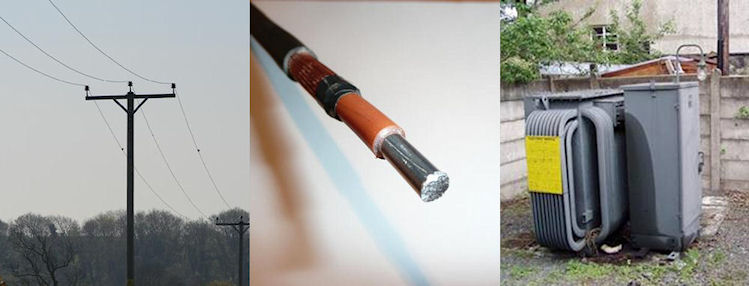 |
 |
|
 |
 |
About Us | Contact |
|
|
09/06/2010 - SAGE recommends new EMF reduction measuresSAGE Second Interim Assessment sent to GovernmentThe Stakeholder Advisory Group on Extremely Low Frequency Electric and Magnetic Fields (EMFs) (known as SAGE) is a UK group set up in 2004 to consider possible precautionary measures in relation to EMFs. SAGE is made up from stakeholders representing a broad spectrum of views, including campaign groups, relevant industries, and the Government. It brings together many areas of expertise, including those with significant expertise in scientific and policy-making disciplines, as well as voices representing sections of the public. SAGE is funded equally by Government, the electricity industry, and the charity CHILDREN with LEUKAEMIA. Alasdair Philips represents Powerwatch on SAGE. SAGE is concerned only with "extremely low frequency" EMFs, such as produced by electrical power. Well-understood effects, found at significantly higher exposure levels, are covered adequately by existing guidelines, which in the UK are set by Government on the recommendations of the Health Protection Agency. Childhood leukaemia has been repeatedly associated with low level EMF exposure in international studies. SAGE was formed in 2004 to consider possible practical precautionary measures to address the possibility of health effects at exposure levels well under current official guideline levels, and to give advice to Government. The second phase of SAGE's work (from 2008 - 2010) covered EMFs caused by electricity distribution networks (e.g. 11 kV lines, underground street cables, substations, etc) and it also considered the difficult issue of how different people and groups approach and interpret the available scientific evidence. There is a wealth of useful, mostly technical, information about the causes of EMFs produced by electricity networks - a major source of elevated magnetic field in the home.
Powerwatch considers the SAGE-2 Report to be a significant step forward in the professional assessment and management of EMF exposure issues. Although the work can be tedious and take a considerable amount of time, it is important for all parties to work together on these complex and important issues. There has been really outstanding commitment and input from Industry and the Department of Health to the work of SAGE. SAGE-2 has delivered some very worthwhile, practical and achievable recommendations. Many members contributed greatly to this new report which is the result of a great team effort. Dr John Swanson, of National Grid, especially deserves thanking for working tirelessly on the documentation that enabled the SAGE group to produce this excellent report. The SAGE-2 Report SAGE makes the following recommendations for precautionary measures concerning distribution systems:
Note: "DNOs" (below) are the Distribution Network Operators (the regional electricity network companies) Some key SAGE-2 recommendations to help reduce EMF exposure
Also in the news010 - Science UpdateIET issues yet another denialist EMF/health effects reportMuch of this section is taken from REVOLT's Newsletter No.299 - with thanks. The IET's Biological Effects Policy Advisory Group (BEPAG) has produced its biennial report on low-level EMF exposure (ELF and RF). It was Press Released on the same day that the SAGE-2 Report was sent to the Government. After a review of new evidence, their conclusions are effectively unchanged from their 2008 report. Professor Tony Barker, a Fellow of the IET and long-term Chairman of BEPAG, said: "There is still a huge amount of interest in whether exposure to mobile phones and electricity pylons has harmful health effects. However, over the years the conclusion of most scientific bodies, including the Institution of Engineering and Technology, has remained substantially the same - that there is no persuasive evidence of this. The absence of robust new evidence of harmful health effects in the past two years is reassuring and is consistent with findings over the last two decades." We believe that there are serious structural problems with BEPAG:
BEPAG's conclusions not actually as strong as the impression it can give to media and decision makers. Its Summary says "the balance of scientific evidence to date does not indicate that harmful effects occur in humans due to low-level exposure to EMFs". They are entitled to their view: "does not indicate" - much depends on how "indicate" is defined, whether to mean, suggest or prove. The WHO through its evaluations does not assess the balance of evidence in that way, rather it recognises the rational possibility of harm. Whether the "balance" is for or against harm is not very relevant, though it makes a good spin for BEPAG and IET. The point should be that the evidence gives genuine grounds for concern. By contrast, BEPAG uses the word "reassuring", which speaks more of its motives. Assertions such as "No generally accepted experimental demonstration of any biological effect, harmful or otherwise, due to such fields has been established" will perplex other scientists who are aware of many such experimental demonstrations at sub-ICNIRP levels, but again much depends on definitions of "generally accepted", "such fields" and "established", and of "environmental levels" in the previous sentence. The section on SAGE at the end of BEPAG's report says "the UK does not have a policy of restrictions on the proximity of homes and powerlines, which was judged disproportionate". While that may be true, it gives a false impression that SAGE might have so judged it. Two alternative views were recognised in SAGE. Only one of these two views judged the policy disproportionate, because that view only recognised the (rare) risk of childhood leukaemia and excluded other associated outcomes like Alzheimer's disease. SAGE-1 noted that the wider consideration would lead to about a hundred-fold larger impact. That would make such precautionary policies proportionate. This page has links to content that requires a .pdf reader such as |


